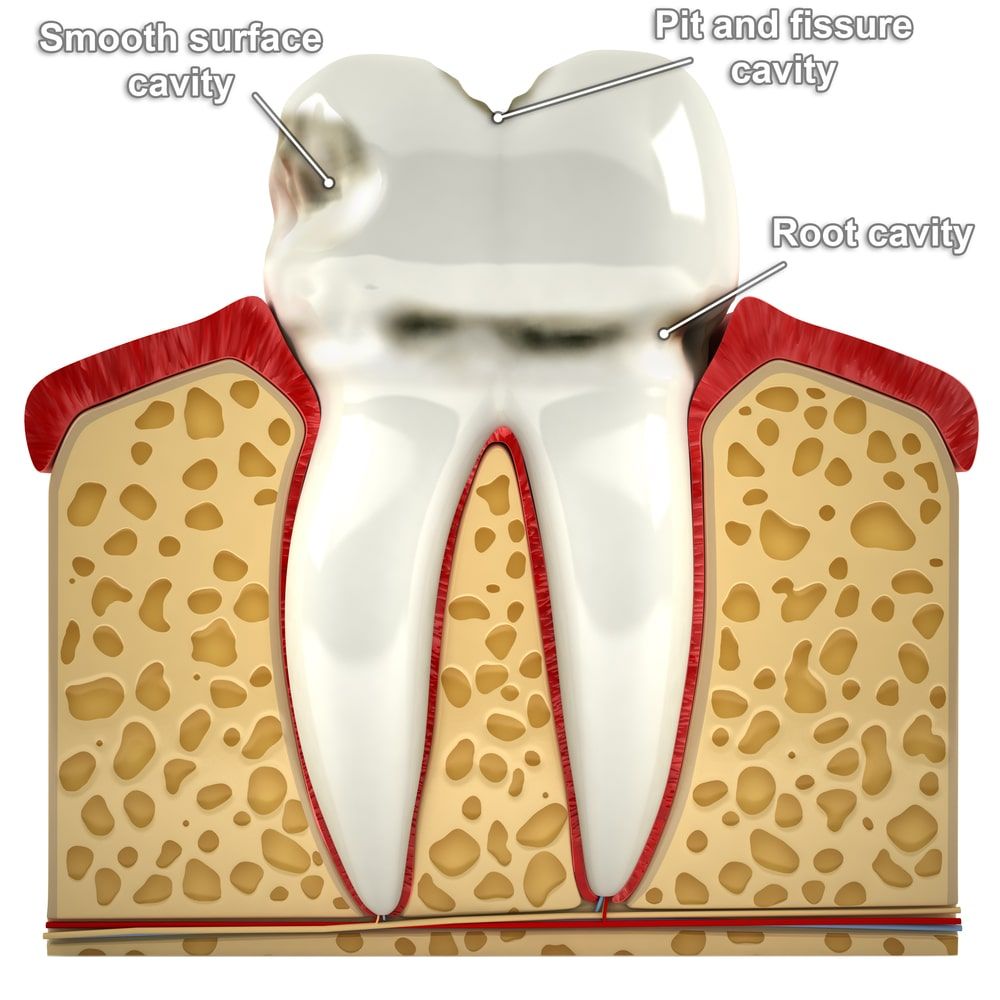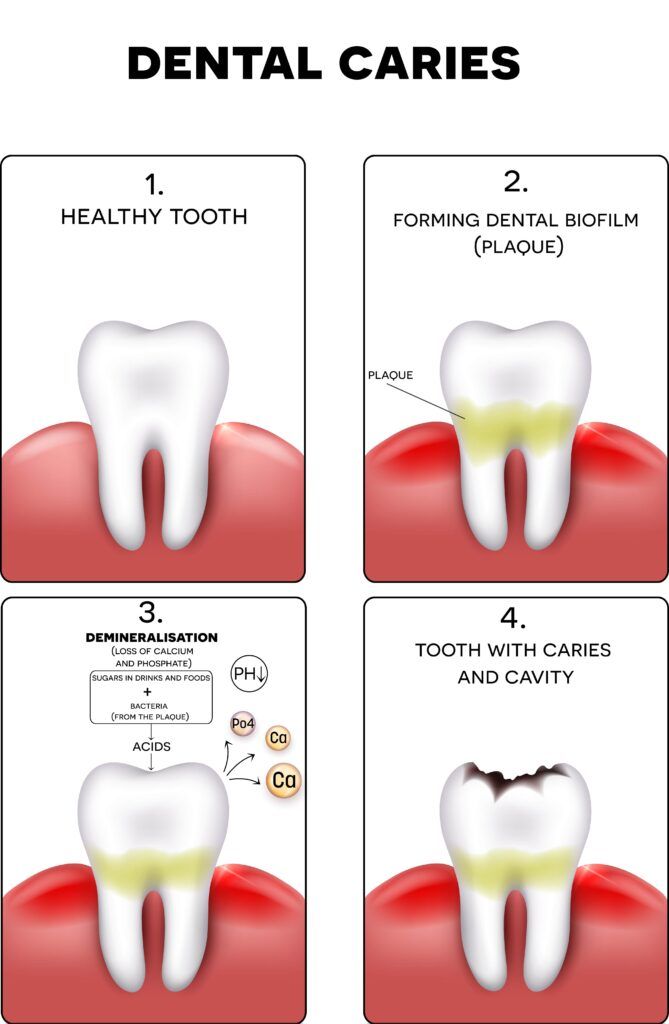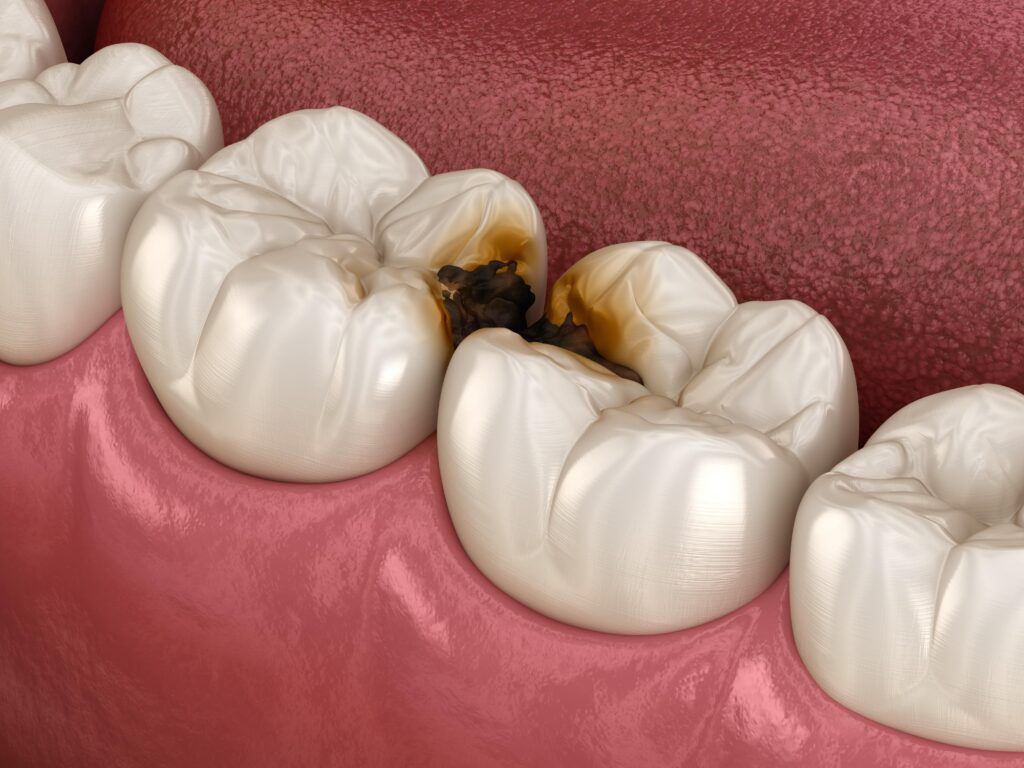Cavities are a common oral health problem that affects many people. Cavities, also known as dental caries, are not just a matter of eating too many sweets. They result from a complex interplay between oral bacteria, dietary habits, and oral hygiene practices. As we explore how cavities form, we’ll unravel the myths and understand the science behind tooth decay. This knowledge is not just academic; it’s crucial for taking proactive steps in maintaining a healthy, happy smile. Whether you’re a dental professional, a curious reader, or someone looking to improve your oral health, this article will provide valuable insights into the world of cavities.
What is a cavity?
First things first, let’s look a little deeper at what a cavity actually is. A cavity, also known as dental caries or tooth decay, is a damaged area in the hard surface of your teeth that develops into tiny openings or holes. Cavities are caused by a combination of factors, including bacteria in your mouth, frequent snacking, sipping sugary drinks, and not cleaning your teeth well.

When you eat or drink foods containing sugars, the bacteria in your mouth produce acids that attack the enamel, the hard outer layer of your tooth. Over time, this acid can break down the enamel, leading to cavities. If not treated, cavities can grow larger and affect deeper layers of your teeth. They can lead to severe toothache, infection, and even tooth loss.
Cavities can form in several areas of a tooth, each with its own unique risks and characteristics. Here’s a breakdown of where cavities commonly develop:
- Pits and Fissures: These are the grooves or crevices found on the chewing surfaces of the back teeth (molars and premolars). Food and bacteria can easily get trapped in these areas, making them prone to decay, especially if one doesn’t brush adequately.
- Between Teeth (Interproximal Cavities): Cavities often form in the spaces between teeth where a toothbrush can’t reach. This is why flossing is crucial, as it removes food particles and plaque from these areas.
- Along the Gum Line: This type of cavity forms on the tooth’s root surface and is more common in older adults who have receding gums. Receding gums expose the roots of the teeth, which don’t have enamel to protect them, making them more susceptible to decay.
- Smooth Surfaces: These cavities occur on the flat exterior surfaces of the teeth, like the front teeth’s smooth areas. They are less common because these areas are easier to clean and don’t have crevices where plaque can accumulate.
- Underneath Fillings: Old or broken fillings can allow bacteria to accumulate and create new decay around the edges or underneath the filling.
Cavities can start small and gradually get larger if they’re not treated. Regular dental check-ups are important to detect cavities early before they develop into more serious problems.
The Making of a Cavity: Step by Step
Cavities don’t form overnight; they are the result of a prolonged process that involves several stages:
Stage 1: Plaque Forms
Our mouths are home to various types of bacteria, some beneficial and some harmful. Plaque is a sticky, colorless film of bacteria that constantly forms on our teeth. When you eat sugar or carbohydrates, which are common in foods like bread, cereal, milk, soda, fruit, cake, or candy, the bacteria in plaque use these sugars as food. They then produce acids as a byproduct.
Stage 2: Plaque Attacks

The acids created by plaque bacteria can attack your tooth’s enamel, the hard, outer surface of your tooth, shortly after you eat or drink anything that contains sugars. Repeated attacks can weaken the enamel and lead to its breakdown. This process is known as demineralization, which involves the loss of minerals from the enamel, making it more vulnerable to decay.
Stage 3: Decay Forms in the Enamel (Enamel Cavity)
Over time, as the enamel loses minerals, a white spot may appear where minerals have been stripped away. This area of decay can be stopped or even reversed at this point with fluoride from toothpaste, water, or dental treatments, as well as by cutting down on sugary snacks. However, if the demineralization process continues, the enamel can deteriorate further, resulting in a cavity.
Stage 4: Decay Reaches the Dentin (Dentin Cavity)
Once the process of decay breaks through the outer enamel, the bacteria and acids can reach the next layer of your tooth, called the dentin. This substance is softer than enamel and less resistant to acid. Unlike enamel, dentin also contains tiny tubes that directly communicate with the nerve of the tooth, causing sensitivity as the decay gets closer to the nerve.
Stage 5: Formation of a Pulp Cavity
As the decay progresses through the dentin, it can move toward the inner tooth material, called the pulp, which contains the tooth’s nerves and blood vessels. The pulp becomes swollen and irritated from the bacteria, and because it’s contained within the hard confines of your tooth, there’s nowhere for the swelling to expand, leading to a toothache.
Preventing Cavities: Tips and Best Practices
Preventing cavities involves more than just brushing your teeth. Here are several tips to keep in mind:
- Maintain Good Oral Hygiene: Brush your teeth at least twice a day with fluoride toothpaste and floss daily.
- Use Dental Products with Fluoride: Including mouthwashes and toothpaste. Fluoride helps to repair enamel and prevent tooth decay.
- Regular Dental Visits: See your dentist regularly for cleanings and examinations.
- Mind Your Diet: Limit acidic and sugary foods and drinks.
- Consider Dental Sealants: A protective coating applied to the chewing surfaces of the back teeth (molars) to protect from decay.
- Stay Hydrated: Drinking water helps to maintain saliva flow and rinses away food particles.
Conclusion
In conclusion, understanding the formation and locations of cavities is crucial for maintaining optimal dental health. Remember, prevention is key. Regular dental check-ups, proper oral hygiene practices, a balanced diet low in sugary foods and beverages, and the use of fluoride are all essential steps in preventing cavities. By staying informed and proactive in our dental care routines, we can significantly reduce the risk of cavities and ensure the longevity of our teeth. Let’s commit to taking care of our oral health not just for a beautiful smile, but for overall well-being. Remember, a healthy mouth is the gateway to a healthy body!

Dr. Sadati possesses extensive experience in all aspects of advanced restorative dentistry, with an emphasis in cosmetic and implant dentistry. He has attained Accredited Fellow status in the American Academy of Cosmetic Dentistry (AACD), the most rigorous, demanding credentialing process in the world. He is the only AACD Accredited Fellow in South Florida.


